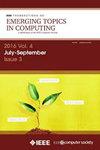A Design Framework for Hardware-Efficient Logarithmic Floating-Point Multipliers
IF 5.1
2区 计算机科学
Q1 COMPUTER SCIENCE, INFORMATION SYSTEMS
IEEE Transactions on Emerging Topics in Computing
Pub Date : 2024-02-19
DOI:10.1109/TETC.2024.3365650
引用次数: 0
Abstract
The symbiotic use of logarithmic approximation in floating-point (FP) multiplication can significantly reduce the hardware complexity of a multiplier. However, it is difficult for a limited number of logarithmic FP multipliers (LFPMs) to fit in a specific error-tolerant application, such as neural networks (NNs) and digital signal processing, due to their unique error characteristics. This article proposes a design framework for generating LFPMs. We consider two FP representation formats with different ranges of mantissas, the IEEE 754 Standard FP Format and the Nearest Power of Two FP Format. For both logarithm and anti-logarithm computation, the applicable regions of inputs are first evenly divided into several intervals, and then approximation methods with negative or positive errors are developed for each sub-region. By using piece-wise functions, different configurations of approximation methods throughout applicable regions are created, leading to LFPMs with various trade-offs between accuracy and hardware cost. The variety of error characteristics of LFPMs is discussed and the generic hardware implementation is illustrated. As case studies, two LFPM designs are presented and evaluated in applications of JPEG compression and NNs. They do not only increase the classification accuracy, but also achieve smaller PDPs compared to the exact FP multiplier, while being more accurate than a recent logarithmic FP design.硬件高效对数浮点运算器设计框架
在浮点(FP)乘法中共生使用对数近似可以显著降低乘法器的硬件复杂性。然而,由于其独特的误差特性,有限数量的对数FP乘法器(LFPMs)很难适应特定的容错应用,例如神经网络(nn)和数字信号处理。本文提出了一个用于生成lfpm的设计框架。我们考虑了两种具有不同尾数范围的FP表示格式,IEEE 754标准FP格式和两FP格式的最近邻幂。对于对数和反对数计算,首先将输入的适用区域均匀划分为几个区间,然后为每个子区域开发具有负或正误差的近似方法。通过使用分段函数,在整个适用区域创建了不同的近似方法配置,从而导致在精度和硬件成本之间进行各种权衡的lfpm。讨论了LFPMs误差特性的变化,并给出了通用硬件实现。作为案例研究,介绍了两种LFPM设计,并在JPEG压缩和神经网络的应用中进行了评估。它们不仅提高了分类精度,而且与精确的FP乘法器相比,还实现了更小的pdp,同时比最近的对数FP设计更准确。
本文章由计算机程序翻译,如有差异,请以英文原文为准。
求助全文
约1分钟内获得全文
求助全文
来源期刊

IEEE Transactions on Emerging Topics in Computing
Computer Science-Computer Science (miscellaneous)
CiteScore
12.10
自引率
5.10%
发文量
113
期刊介绍:
IEEE Transactions on Emerging Topics in Computing publishes papers on emerging aspects of computer science, computing technology, and computing applications not currently covered by other IEEE Computer Society Transactions. Some examples of emerging topics in computing include: IT for Green, Synthetic and organic computing structures and systems, Advanced analytics, Social/occupational computing, Location-based/client computer systems, Morphic computer design, Electronic game systems, & Health-care IT.
 求助内容:
求助内容: 应助结果提醒方式:
应助结果提醒方式:


